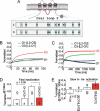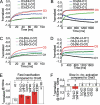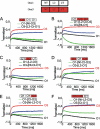Cooperativeness of Orai cytosolic domains tunes subtype-specific gating
- PMID: 21220423
- PMCID: PMC3048740
- DOI: 10.1074/jbc.M110.187179
Cooperativeness of Orai cytosolic domains tunes subtype-specific gating
Abstract
Activation of immune cells is triggered by the Ca(2+) release-activated Ca(2+) current, which is mediated via channels of the Orai protein family. A key gating process of the three Orai channel isoforms to prevent Ca(2+) overload is fast inactivation, most pronounced in Orai3. A subsequent reactivation is a unique gating characteristic of Orai1 channels, whereas Orai2 and Orai3 currents display a second, slow inactivation phase. Employing a chimeric approach by sequential swapping of respective intra- and extracellular regions between Orai1 and Orai3, we show here that Orai1 specific proline/arginine-rich domains in the N terminus mediate reactivation, whereas the second, intracellular loop modulates fast and slow gating processes. Swapping C-terminal strands lacks a significant impact. However, simultaneous transfer of Orai3 N terminus and its second loop or C terminus in an Orai1 chimera substantially increases fast inactivation centered between wild-type channels. Concomitant swap of all three cytosolic strands from Orai3 onto Orai1 fully conveys Orai3-like gating characteristics, in a strongly cooperative manner. In conclusion, Orai subtype-specific gating requires a cooperative interplay of all three cytosolic domains.
Figures






References
Publication types
MeSH terms
Substances
Grants and funding
LinkOut - more resources
Full Text Sources
Miscellaneous

